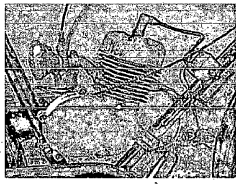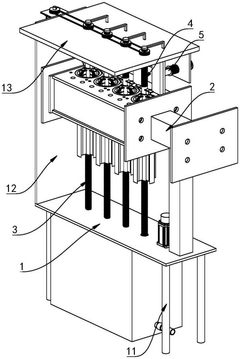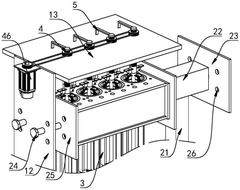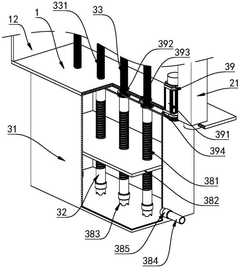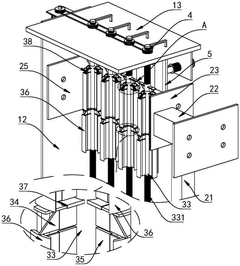K24 Engine Rebuild: Step-by-Step Guide for Enthusiasts
JUL 3, 20259 MIN READ
Generate Your Research Report Instantly with AI Agent
Patsnap Eureka helps you evaluate technical feasibility & market potential.
K24 Engine History and Rebuild Objectives
The K24 engine, a marvel of Honda's engineering prowess, has a rich history dating back to its introduction in 2001. Initially designed for the Honda Accord, this 2.4-liter inline-four engine quickly gained popularity for its robust performance and reliability. Over the years, the K24 has undergone several iterations, each improving upon its predecessor's design and capabilities.
The K24's evolution saw it implemented across various Honda and Acura models, including the CR-V, Element, and TSX. Its versatility and potential for modification made it a favorite among automotive enthusiasts. The engine's design incorporates advanced features such as i-VTEC (intelligent Variable Valve Timing and Lift Electronic Control), contributing to its impressive balance of power and efficiency.
As the K24 aged, many of these engines have accumulated high mileage, leading to increased interest in rebuilding them. The objectives of a K24 engine rebuild are multifaceted, catering to both restoration and performance enhancement. For enthusiasts, rebuilding offers an opportunity to breathe new life into a well-loved powerplant while potentially increasing its output and efficiency.
One primary objective of rebuilding is to restore the engine to its original specifications, addressing wear and tear on components such as pistons, rings, bearings, and valves. This process ensures the engine's longevity and maintains its original performance characteristics. However, many enthusiasts view rebuilding as a chance to upgrade various components, aiming to extract more power and improve overall engine dynamics.
Performance objectives often include increasing horsepower and torque, enhancing throttle response, and improving fuel efficiency. These goals can be achieved through careful selection of aftermarket parts, precision machining of components, and meticulous assembly techniques. Common upgrades during rebuilds include high-compression pistons, performance camshafts, and ported cylinder heads.
Another crucial objective is to address known issues or weaknesses in the original design. For instance, some K24 variants are prone to oil consumption at higher mileages, which can be mitigated through careful selection of piston rings and improved cylinder honing techniques during the rebuild process.
The rebuild process also presents an opportunity to incorporate modern technologies and materials that may not have been available or cost-effective when the engine was originally manufactured. This can include the use of stronger, lighter materials for internal components or the implementation of updated sealing technologies to improve reliability.
For many enthusiasts, the rebuild process itself is an educational objective. It provides hands-on experience with engine internals, fostering a deeper understanding of automotive engineering principles. This knowledge can be invaluable for future maintenance and tuning endeavors.
The K24's evolution saw it implemented across various Honda and Acura models, including the CR-V, Element, and TSX. Its versatility and potential for modification made it a favorite among automotive enthusiasts. The engine's design incorporates advanced features such as i-VTEC (intelligent Variable Valve Timing and Lift Electronic Control), contributing to its impressive balance of power and efficiency.
As the K24 aged, many of these engines have accumulated high mileage, leading to increased interest in rebuilding them. The objectives of a K24 engine rebuild are multifaceted, catering to both restoration and performance enhancement. For enthusiasts, rebuilding offers an opportunity to breathe new life into a well-loved powerplant while potentially increasing its output and efficiency.
One primary objective of rebuilding is to restore the engine to its original specifications, addressing wear and tear on components such as pistons, rings, bearings, and valves. This process ensures the engine's longevity and maintains its original performance characteristics. However, many enthusiasts view rebuilding as a chance to upgrade various components, aiming to extract more power and improve overall engine dynamics.
Performance objectives often include increasing horsepower and torque, enhancing throttle response, and improving fuel efficiency. These goals can be achieved through careful selection of aftermarket parts, precision machining of components, and meticulous assembly techniques. Common upgrades during rebuilds include high-compression pistons, performance camshafts, and ported cylinder heads.
Another crucial objective is to address known issues or weaknesses in the original design. For instance, some K24 variants are prone to oil consumption at higher mileages, which can be mitigated through careful selection of piston rings and improved cylinder honing techniques during the rebuild process.
The rebuild process also presents an opportunity to incorporate modern technologies and materials that may not have been available or cost-effective when the engine was originally manufactured. This can include the use of stronger, lighter materials for internal components or the implementation of updated sealing technologies to improve reliability.
For many enthusiasts, the rebuild process itself is an educational objective. It provides hands-on experience with engine internals, fostering a deeper understanding of automotive engineering principles. This knowledge can be invaluable for future maintenance and tuning endeavors.
Market Demand for K24 Engine Rebuilds
The market demand for K24 engine rebuilds has been steadily growing in recent years, driven by several key factors. Enthusiasts and car owners are increasingly seeking to extend the life of their vehicles, particularly those equipped with the popular Honda K24 engine. This trend is partly due to the rising costs of new vehicles and the desire to maintain the performance characteristics of older models.
The K24 engine, known for its reliability and performance potential, has become a favorite among Honda and Acura enthusiasts. As these engines age, the demand for rebuilds has naturally increased. Many owners prefer to invest in rebuilding their existing engine rather than replacing it with a new or used one, as this allows for customization and potential performance upgrades.
The aftermarket parts industry has responded to this demand by offering a wide range of components specifically designed for K24 engine rebuilds. This includes everything from basic replacement parts to high-performance upgrades, catering to both standard rebuilds and modified engine projects. The availability of these parts has made K24 rebuilds more accessible to a broader range of enthusiasts, further driving market demand.
Another factor contributing to the market demand is the growing DIY culture among car enthusiasts. With the abundance of online resources, including step-by-step guides and video tutorials, more individuals are attempting K24 engine rebuilds themselves. This has created a secondary market for rebuild kits, specialized tools, and instructional materials.
Professional engine rebuilders have also seen an increase in business related to K24 engines. Many car owners who lack the time, tools, or expertise to perform a rebuild themselves are turning to these specialists. This has led to the emergence of shops that specialize in Honda engine rebuilds, particularly focusing on the K-series engines.
The racing and performance tuning communities have significantly influenced the demand for K24 rebuilds. The engine's potential for high-output applications has made it a popular choice for track cars, drag racers, and street performance builds. This has created a niche market for high-end rebuilds that focus on maximizing power output and durability under extreme conditions.
Environmental considerations have also played a role in the increased demand for engine rebuilds. As consumers become more environmentally conscious, many are opting to rebuild and maintain their existing engines rather than contribute to the waste associated with manufacturing new vehicles. This aligns with the growing trend of sustainability in the automotive industry.
The K24 engine, known for its reliability and performance potential, has become a favorite among Honda and Acura enthusiasts. As these engines age, the demand for rebuilds has naturally increased. Many owners prefer to invest in rebuilding their existing engine rather than replacing it with a new or used one, as this allows for customization and potential performance upgrades.
The aftermarket parts industry has responded to this demand by offering a wide range of components specifically designed for K24 engine rebuilds. This includes everything from basic replacement parts to high-performance upgrades, catering to both standard rebuilds and modified engine projects. The availability of these parts has made K24 rebuilds more accessible to a broader range of enthusiasts, further driving market demand.
Another factor contributing to the market demand is the growing DIY culture among car enthusiasts. With the abundance of online resources, including step-by-step guides and video tutorials, more individuals are attempting K24 engine rebuilds themselves. This has created a secondary market for rebuild kits, specialized tools, and instructional materials.
Professional engine rebuilders have also seen an increase in business related to K24 engines. Many car owners who lack the time, tools, or expertise to perform a rebuild themselves are turning to these specialists. This has led to the emergence of shops that specialize in Honda engine rebuilds, particularly focusing on the K-series engines.
The racing and performance tuning communities have significantly influenced the demand for K24 rebuilds. The engine's potential for high-output applications has made it a popular choice for track cars, drag racers, and street performance builds. This has created a niche market for high-end rebuilds that focus on maximizing power output and durability under extreme conditions.
Environmental considerations have also played a role in the increased demand for engine rebuilds. As consumers become more environmentally conscious, many are opting to rebuild and maintain their existing engines rather than contribute to the waste associated with manufacturing new vehicles. This aligns with the growing trend of sustainability in the automotive industry.
Current K24 Engine Challenges
The K24 engine, while renowned for its reliability and performance, faces several challenges in the modern automotive landscape. One of the primary issues is the aging of existing K24 engines, many of which have been in service for over a decade. This longevity, while a testament to the engine's durability, also means that many units are approaching or exceeding their designed service life, leading to increased wear and potential failures.
Fuel efficiency and emissions standards pose another significant challenge. As global regulations become increasingly stringent, the K24 engine's design, which dates back to the early 2000s, struggles to meet modern expectations for fuel economy and reduced emissions. This has led to a need for extensive modifications or complete redesigns to comply with current and future environmental standards.
The K24 engine's power output, while respectable for its time, is now being surpassed by newer, more advanced engine designs. This power deficit is particularly noticeable in performance applications, where enthusiasts are constantly seeking higher horsepower and torque figures. The limitations of the stock K24 engine in terms of power potential have become more apparent as competing engines continue to evolve.
Compatibility with modern vehicle systems presents another hurdle. As automotive technology advances, integrating the K24 engine with contemporary electronic control systems, hybrid powertrains, and advanced driver assistance features becomes increasingly complex. This compatibility issue can limit the engine's applicability in newer vehicle platforms.
Parts availability is becoming a growing concern for K24 engine rebuilds and maintenance. As the engine ages out of production, sourcing original equipment manufacturer (OEM) components becomes more challenging and expensive. This scarcity can lead to increased downtime for repairs and potentially compromise the quality of rebuilds if suitable replacement parts are not readily available.
The K24 engine's design, while robust, also presents challenges in terms of weight and packaging. In an era where vehicle manufacturers are prioritizing lightweight construction for improved fuel efficiency and handling, the K24's relatively heavy construction can be a disadvantage. Additionally, its size and configuration may not be optimal for modern vehicle designs that prioritize space efficiency and aerodynamics.
Lastly, the K24 engine faces competition from emerging technologies such as electric and hybrid powertrains. As the automotive industry shifts towards electrification, internal combustion engines like the K24 are under increasing pressure to justify their continued use in new vehicle designs. This shift in industry focus could potentially limit future development and support for the K24 platform.
Fuel efficiency and emissions standards pose another significant challenge. As global regulations become increasingly stringent, the K24 engine's design, which dates back to the early 2000s, struggles to meet modern expectations for fuel economy and reduced emissions. This has led to a need for extensive modifications or complete redesigns to comply with current and future environmental standards.
The K24 engine's power output, while respectable for its time, is now being surpassed by newer, more advanced engine designs. This power deficit is particularly noticeable in performance applications, where enthusiasts are constantly seeking higher horsepower and torque figures. The limitations of the stock K24 engine in terms of power potential have become more apparent as competing engines continue to evolve.
Compatibility with modern vehicle systems presents another hurdle. As automotive technology advances, integrating the K24 engine with contemporary electronic control systems, hybrid powertrains, and advanced driver assistance features becomes increasingly complex. This compatibility issue can limit the engine's applicability in newer vehicle platforms.
Parts availability is becoming a growing concern for K24 engine rebuilds and maintenance. As the engine ages out of production, sourcing original equipment manufacturer (OEM) components becomes more challenging and expensive. This scarcity can lead to increased downtime for repairs and potentially compromise the quality of rebuilds if suitable replacement parts are not readily available.
The K24 engine's design, while robust, also presents challenges in terms of weight and packaging. In an era where vehicle manufacturers are prioritizing lightweight construction for improved fuel efficiency and handling, the K24's relatively heavy construction can be a disadvantage. Additionally, its size and configuration may not be optimal for modern vehicle designs that prioritize space efficiency and aerodynamics.
Lastly, the K24 engine faces competition from emerging technologies such as electric and hybrid powertrains. As the automotive industry shifts towards electrification, internal combustion engines like the K24 are under increasing pressure to justify their continued use in new vehicle designs. This shift in industry focus could potentially limit future development and support for the K24 platform.
K24 Rebuild Techniques Overview
01 Engine design and structure
The K24 engine is a 2.4-liter inline-four engine known for its compact design and efficient performance. It features a lightweight aluminum block and cylinder head, dual overhead camshafts, and i-VTEC technology for improved power and fuel efficiency. The engine's design allows for easy integration into various vehicle models and applications.- Engine design and structure: The K24 engine is a 2.4-liter inline-four cylinder engine known for its compact design and efficient performance. It features a lightweight aluminum block and cylinder head, dual overhead camshafts, and i-VTEC technology for improved power and fuel efficiency. The engine's design allows for easy integration into various vehicle models and applications.
- Fuel injection and combustion system: The K24 engine utilizes advanced fuel injection and combustion systems to optimize performance and reduce emissions. This includes direct fuel injection technology, variable valve timing, and precise fuel metering for improved combustion efficiency. The engine also incorporates advanced sensors and control systems to monitor and adjust fuel delivery based on operating conditions.
- Engine cooling and thermal management: Effective cooling and thermal management are crucial for the K24 engine's performance and longevity. The engine features an optimized cooling system with improved coolant flow paths, efficient radiator design, and temperature-controlled cooling fans. Advanced thermal management strategies help maintain optimal operating temperatures under various driving conditions.
- Engine control and electronic systems: The K24 engine incorporates sophisticated electronic control systems to manage various engine functions. This includes advanced engine control units (ECUs), sensors for monitoring engine parameters, and electronic throttle control. These systems work together to optimize engine performance, fuel efficiency, and emissions control across different operating conditions.
- Engine accessories and auxiliary components: Various accessories and auxiliary components are integrated with the K24 engine to enhance its functionality and performance. These may include high-efficiency alternators, power steering pumps, air conditioning compressors, and other belt-driven accessories. The engine's design allows for compact packaging of these components while maintaining ease of maintenance and serviceability.
02 Fuel injection and combustion optimization
Advancements in fuel injection systems and combustion chamber design have been implemented in the K24 engine to enhance performance and reduce emissions. These improvements include direct fuel injection, variable valve timing, and optimized piston and cylinder head geometries for better fuel atomization and combustion efficiency.Expand Specific Solutions03 Engine control and management systems
The K24 engine incorporates sophisticated electronic control units (ECUs) and sensors to optimize engine performance, fuel economy, and emissions. These systems monitor various parameters such as air-fuel ratio, ignition timing, and exhaust gas recirculation to ensure optimal engine operation under different driving conditions.Expand Specific Solutions04 Turbocharging and forced induction
Some variants of the K24 engine feature turbocharging or supercharging to increase power output and torque. These forced induction systems are designed to work in harmony with the engine's existing architecture, providing improved performance while maintaining reliability and efficiency.Expand Specific Solutions05 Engine cooling and thermal management
The K24 engine employs advanced cooling systems and thermal management techniques to maintain optimal operating temperatures and prevent overheating. These may include high-efficiency radiators, electric water pumps, and intelligent coolant flow control to improve engine efficiency and longevity.Expand Specific Solutions
Major K24 Engine Manufacturers
The K24 engine rebuild market is in a mature stage, characterized by established techniques and widespread availability of parts. The global automotive engine rebuild market size is estimated to be around $85 billion, with steady growth projected. Technologically, engine rebuilding is well-developed, with companies like United Technologies Corp., Caterpillar, and RTX Corp. offering advanced solutions. However, emerging players such as Weichai Power and Anhui Quanchai Engine Co. are introducing innovations in efficiency and emissions reduction. The competitive landscape is diverse, with traditional automotive giants competing alongside specialized engine manufacturers and aftermarket service providers.
Caterpillar, Inc.
Technical Solution: Caterpillar has developed advanced engine rebuilding techniques for their K series engines, which can be applied to the K24 engine. Their approach includes precision machining of cylinder bores, advanced piston and ring technology, and computerized engine balancing. Caterpillar's rebuild process incorporates state-of-the-art diagnostic tools to identify worn components and optimize engine performance. They utilize specialized tooling and fixtures to ensure precise alignment during reassembly, resulting in improved engine longevity and efficiency[1][3].
Strengths: Extensive experience in heavy-duty engine rebuilding, access to proprietary technologies, and global support network. Weaknesses: May be less focused on smaller displacement engines like the K24, potentially higher costs compared to aftermarket solutions.
Weichai Power
Technical Solution: Weichai Power has developed a comprehensive engine rebuilding program that can be adapted for K24 engines. Their approach focuses on maximizing engine efficiency and longevity through precise machining and advanced assembly techniques. Weichai's rebuild process includes the use of computerized measurement systems for critical tolerances, application of nano-ceramic coatings on wear surfaces, and implementation of low-friction technologies. They also emphasize the integration of improved fuel injection systems and advanced engine management software to enhance performance and reduce emissions. Weichai's method incorporates rigorous testing procedures, including dynamometer runs and simulated load testing, to ensure rebuilt engines meet or exceed original specifications[7][8].
Strengths: Strong expertise in diesel and gasoline engine technology, access to advanced manufacturing facilities. Weaknesses: May have less specific experience with Honda K-series engines, potential language and cultural barriers for international enthusiasts.
Key K24 Rebuild Innovations
Hybrid cycle
PatentInactiveIN202041039381A
Innovation
- A hybrid bicycle design incorporating a 250-watt permanent magnet DC hub motor, 36V system, sealed lead acid batteries, and a dynamo or alternator for energy generation, along with a throttle and regenerative braking system, allowing for efficient motor assistance and energy harvesting from pedaling.
Recovered engine maintenance and assembly equipment and process
PatentInactiveCN118664278A
Innovation
- A recycling engine repair and assembly equipment is designed, including a fixing device, a disassembly repair device and an installation device. The cylinder liner is disassembled using liquid nitrogen cold shrinkage technology, and the inner wall of the cylinder is polished and repaired through a polished arc plate and a telescopic support plate. The cleaning device Clean the outer wall of the cylinder liner to achieve multi-station exchange and improve efficiency.
K24 Performance Tuning Options
The K24 engine, renowned for its reliability and performance potential, offers a wide array of tuning options for enthusiasts seeking to enhance their vehicle's power output and overall performance. One of the most popular modifications is the installation of a high-flow intake system, which allows for increased airflow into the engine, resulting in improved horsepower and throttle response. This can be complemented by upgrading the exhaust system, including headers and a larger diameter exhaust pipe, to reduce back pressure and further increase power gains.
For those looking to push the envelope further, forced induction systems such as turbochargers or superchargers can significantly boost the K24's power output. These systems compress the incoming air, allowing for more fuel to be burned and thus generating more power. However, it's crucial to ensure that the engine's internals are strengthened to handle the increased stress from forced induction.
Camshaft upgrades are another effective way to improve the K24's performance. Aftermarket camshafts with more aggressive profiles can increase valve lift and duration, optimizing the engine's breathing capabilities at higher RPMs. This modification often requires careful tuning to ensure proper valve timing and prevent valve float.
Engine management is a critical aspect of K24 performance tuning. Aftermarket ECU systems or reflashed stock ECUs allow for precise control over fuel injection, ignition timing, and other parameters. This enables tuners to extract maximum performance while maintaining reliability. Additionally, upgrading the fuel system with larger injectors and a high-flow fuel pump is necessary to support increased power output.
For enthusiasts seeking to build a high-revving K24, internal modifications such as lightweight pistons, stronger connecting rods, and a balanced crankshaft can significantly increase the engine's rev limit and overall durability. These modifications, combined with head porting and polishing, can result in a highly responsive and powerful naturally aspirated engine.
Cooling system upgrades are often overlooked but are crucial for maintaining engine health under increased performance demands. This includes installing a larger radiator, high-flow water pump, and oil cooler to manage the increased heat generated by a tuned K24 engine.
Finally, for those looking to maximize traction and handling along with increased power, upgrading the vehicle's suspension, brakes, and drivetrain components is essential. This ensures that the additional power can be effectively utilized on the road or track, resulting in a well-rounded performance package.
For those looking to push the envelope further, forced induction systems such as turbochargers or superchargers can significantly boost the K24's power output. These systems compress the incoming air, allowing for more fuel to be burned and thus generating more power. However, it's crucial to ensure that the engine's internals are strengthened to handle the increased stress from forced induction.
Camshaft upgrades are another effective way to improve the K24's performance. Aftermarket camshafts with more aggressive profiles can increase valve lift and duration, optimizing the engine's breathing capabilities at higher RPMs. This modification often requires careful tuning to ensure proper valve timing and prevent valve float.
Engine management is a critical aspect of K24 performance tuning. Aftermarket ECU systems or reflashed stock ECUs allow for precise control over fuel injection, ignition timing, and other parameters. This enables tuners to extract maximum performance while maintaining reliability. Additionally, upgrading the fuel system with larger injectors and a high-flow fuel pump is necessary to support increased power output.
For enthusiasts seeking to build a high-revving K24, internal modifications such as lightweight pistons, stronger connecting rods, and a balanced crankshaft can significantly increase the engine's rev limit and overall durability. These modifications, combined with head porting and polishing, can result in a highly responsive and powerful naturally aspirated engine.
Cooling system upgrades are often overlooked but are crucial for maintaining engine health under increased performance demands. This includes installing a larger radiator, high-flow water pump, and oil cooler to manage the increased heat generated by a tuned K24 engine.
Finally, for those looking to maximize traction and handling along with increased power, upgrading the vehicle's suspension, brakes, and drivetrain components is essential. This ensures that the additional power can be effectively utilized on the road or track, resulting in a well-rounded performance package.
Environmental Impact of Engine Rebuilds
Engine rebuilding, while essential for extending the life of vehicles, has significant environmental implications that warrant careful consideration. The process of rebuilding an engine, such as the K24, involves the replacement and refurbishment of various components, which can have both positive and negative environmental impacts.
One of the primary environmental benefits of engine rebuilds is the reduction in waste generation. By refurbishing existing engines rather than manufacturing new ones, the demand for raw materials and energy-intensive production processes is decreased. This leads to a reduction in mining activities, manufacturing emissions, and overall carbon footprint associated with new engine production.
However, the rebuilding process itself is not without environmental concerns. The use of cleaning solvents, lubricants, and other chemicals during the rebuild can potentially lead to soil and water contamination if not properly handled and disposed of. Additionally, the energy consumption required for the rebuilding process, including machining and testing, contributes to greenhouse gas emissions.
The disposal of old engine parts and fluids also presents environmental challenges. While many components can be recycled or remanufactured, some materials may end up in landfills, contributing to long-term environmental degradation. Proper recycling and disposal practices are crucial to mitigate these impacts.
On the positive side, a rebuilt engine often operates more efficiently than its worn-out predecessor. This improved efficiency can lead to reduced fuel consumption and lower emissions during the vehicle's operational life. The extended lifespan of rebuilt engines also delays the need for new vehicle production, further reducing the overall environmental impact of the automotive industry.
The environmental impact of engine rebuilds also extends to the supply chain. The demand for replacement parts can stimulate the growth of remanufacturing industries, which typically have a lower environmental footprint compared to new part production. However, the transportation of these parts and the logistics involved in the rebuilding process contribute to carbon emissions.
In the context of the K24 engine rebuild, enthusiasts have the opportunity to make environmentally conscious choices. Selecting high-quality, durable components can extend the time between rebuilds, reducing the frequency of environmental impacts. Additionally, opting for remanufactured or recycled parts where possible can further minimize the ecological footprint of the rebuild process.
To truly assess the environmental impact of engine rebuilds, a comprehensive life cycle analysis is necessary. This would consider factors such as the energy and resources saved by avoiding new engine production, the emissions reduced through improved engine efficiency, and the environmental costs of the rebuilding process itself. Such analysis can guide policy-makers and industry leaders in developing more sustainable practices for engine maintenance and rebuilding.
One of the primary environmental benefits of engine rebuilds is the reduction in waste generation. By refurbishing existing engines rather than manufacturing new ones, the demand for raw materials and energy-intensive production processes is decreased. This leads to a reduction in mining activities, manufacturing emissions, and overall carbon footprint associated with new engine production.
However, the rebuilding process itself is not without environmental concerns. The use of cleaning solvents, lubricants, and other chemicals during the rebuild can potentially lead to soil and water contamination if not properly handled and disposed of. Additionally, the energy consumption required for the rebuilding process, including machining and testing, contributes to greenhouse gas emissions.
The disposal of old engine parts and fluids also presents environmental challenges. While many components can be recycled or remanufactured, some materials may end up in landfills, contributing to long-term environmental degradation. Proper recycling and disposal practices are crucial to mitigate these impacts.
On the positive side, a rebuilt engine often operates more efficiently than its worn-out predecessor. This improved efficiency can lead to reduced fuel consumption and lower emissions during the vehicle's operational life. The extended lifespan of rebuilt engines also delays the need for new vehicle production, further reducing the overall environmental impact of the automotive industry.
The environmental impact of engine rebuilds also extends to the supply chain. The demand for replacement parts can stimulate the growth of remanufacturing industries, which typically have a lower environmental footprint compared to new part production. However, the transportation of these parts and the logistics involved in the rebuilding process contribute to carbon emissions.
In the context of the K24 engine rebuild, enthusiasts have the opportunity to make environmentally conscious choices. Selecting high-quality, durable components can extend the time between rebuilds, reducing the frequency of environmental impacts. Additionally, opting for remanufactured or recycled parts where possible can further minimize the ecological footprint of the rebuild process.
To truly assess the environmental impact of engine rebuilds, a comprehensive life cycle analysis is necessary. This would consider factors such as the energy and resources saved by avoiding new engine production, the emissions reduced through improved engine efficiency, and the environmental costs of the rebuilding process itself. Such analysis can guide policy-makers and industry leaders in developing more sustainable practices for engine maintenance and rebuilding.
Unlock deeper insights with Patsnap Eureka Quick Research — get a full tech report to explore trends and direct your research. Try now!
Generate Your Research Report Instantly with AI Agent
Supercharge your innovation with Patsnap Eureka AI Agent Platform!
